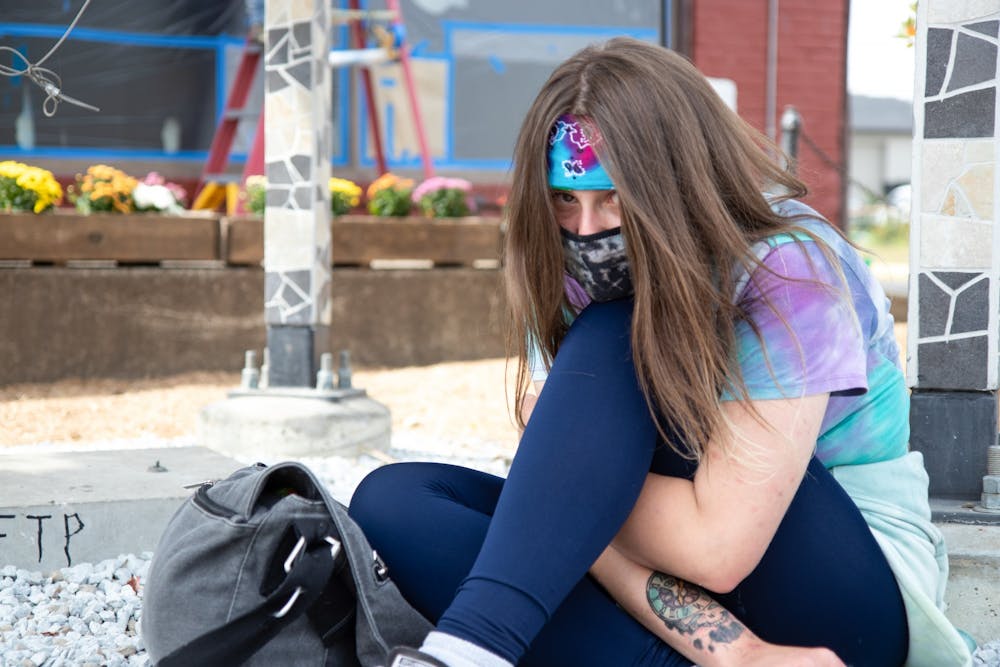Jade was walking along a street of nondescript condos and feeling scared. She thought she and her boyfriend weren’t alone.
It was July, and Jade Wessel, 20, had been living on Bloomington’s streets without stable housing for about three months. She moved from her hometown, Bedford, Indiana, in April. The only belongings she had were the things she could keep in a bag or at her aunt’s apartment.
She and her boyfriend, Southside, were walking on Odell Drive with nowhere to go. She thought someone was following them. Jade was numb with fear. She was convinced it was a zombie.
“We gotta go,” she said. “Come on we gotta run.”
Jade thought the world was ending.
Southside didn’t understand why she was scared and wouldn’t follow. She ran ahead of him until she bumped into a friend who had walked off on her own earlier. Jade didn’t know what was happening. She was sober because she and Southside hadn’t been able to find any drugs that day. That made what she saw all the more confusing.
Southside caught up to them, and they went to a spot in the woods where they could sit while Jade calmed down. He told Jade it was just a drunk person on Odell.
This wasn’t the first time Jade had felt an irrational fear of the undead, but it was the only time she couldn’t separate fear and reality. Jade had dealt with irrational fears most of her life. When she was a child and didn’t know where her mother was, she would become convinced she was dead. Sometimes Jade thought she could hear an army of zombies marching toward her or that someone might break in and kill her. She said a number of family members had dealt with mental health issues including OCD, nervous breakdowns, neuroticism and Alzheimer’s.
For a while, Jade thought she would grow out of her fears. Now she was an adult, and they were only worse.
The fears Jade was facing were complicated and personal, but she wasn’t alone in feeling like it could be the end of the world. There wasn’t a zombie apocalypse, but it was early in the coronavirus pandemic during a summer of unrest. In July, hundreds of thousands of people around the world were being infected and thousands were dying each day. By the end of the year, more than 1.6 million people would be dead. Across the country, people were marching in the streets protesting systemic racial injustice and meeting violent responses from police. On the West Coast and Gulf Coast, massive storm events were growing more intense and frequent as the planet warmed to a simmer.
Jade came to Bloomington in 2020 on the cusp of her own independence. In Bedford, she left behind a breakup with a boyfriend she once called the die-hard love of her life, her immediate family and the doom she felt when she thought about being stuck in that small town.
“I always knew I had to get out of Bedford because you will become a lifer — quick,” Jade said.
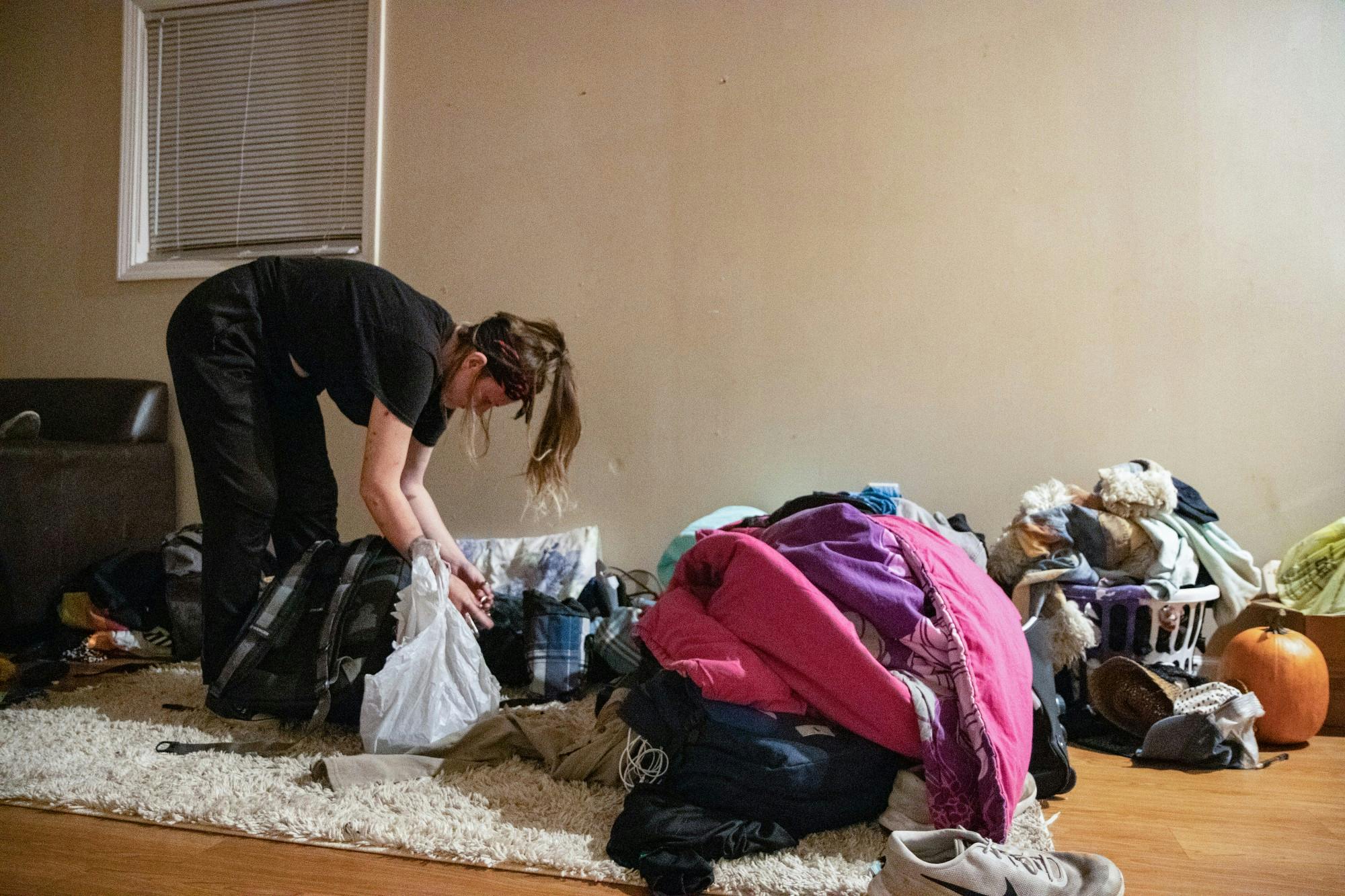
She kept her job at the KFC in Bedford and planned on getting there each day with Bertha,her dark green 1998 Chevy Lumina she’d named for its old and “frumpy” personality. In April, she totaled Bertha downtown. Her stimulus check got her a cheap van, but it was no Bertha and broke down in days. Without a reliable way to get to Bedford, Jade was forced to quit her job.
While people quarantined in their houses, Jade visited her aunt Lisa and uncle Rhett in South Bloomington. They had experienced homelessness for years in Bedford and Bloomington but now lived at the Crawford, an apartment complex that offered permanent housing to people experiencing chronic homelessness due to disabilities. Jade visited her aunt and began to get to know people. She tagged along with new friends, for a while staying in a different Airbnb every few days and sleeping in Seminary Square Park when she needed to. Jade ate meals at Shalom Community Center and spent time with her new boyfriend. In November, Jade would look back on this part of her life in Bloomington as fast-paced and luxurious
“It’s cool,” Jade said. “We’re just rolling with it and having fun.”
Jade’s hair falls past her shoulders in straight, brown tresses that go light blonde at the ends. She has a bright face with warm eyes. She likes to look good and has a habit of staying in the bathroom too long. On her forearm, she has a tattoo of a Grateful Dead skull with a clock in its forehead. The hands strike 7:08 for the shared birthday of her mother and grandfather Pappy. Jade is smart but easily bored. She quoted Socrates and Bertrand Russel as easily as her favorite movies. Above all else, Jade values the time she has on Earth and tries to shed the expectations of a young adult in favor of a life free of inhibition. She described herself as a drug addict but a cautious one. Jade figured she would never be a fully sober person.
She said she had been sober the year before she came to Bloomington, but she relapsed right before moving here. Her drugs of choice were meth and heroin. She thought the archetype of the heroin addict was “the coolest, the die-hard, end all be all,” but she really liked meth better. Jade readily admitted her addictions and had faced consequences for using drugs, but she didn’t see as clearly how they threatened her life. She said she realized the drugs might one day kill her, but said she was too young and smart about using to worry. But every day was another test of her survival.
When she was a child, Jade dreamed of becoming a movie director. Her mom had a drug addiction and wasn’t always around. Jade often didn’t know where she was. When they were together, watching movies bonded them. Their banter was made up of movie quotes. “If you want hamburger helper, go find some other mother,” her mother would tell her. Horror movies were a favorite. Jade said her fifth birthday was “Bride of Chucky” themed. She felt like her mother truly understood who she was.
“Even if I was alone at the time,” Jade said, “I knew that there was somebody else in the world that understood all of the parts of me that didn’t make sense to anybody else.”
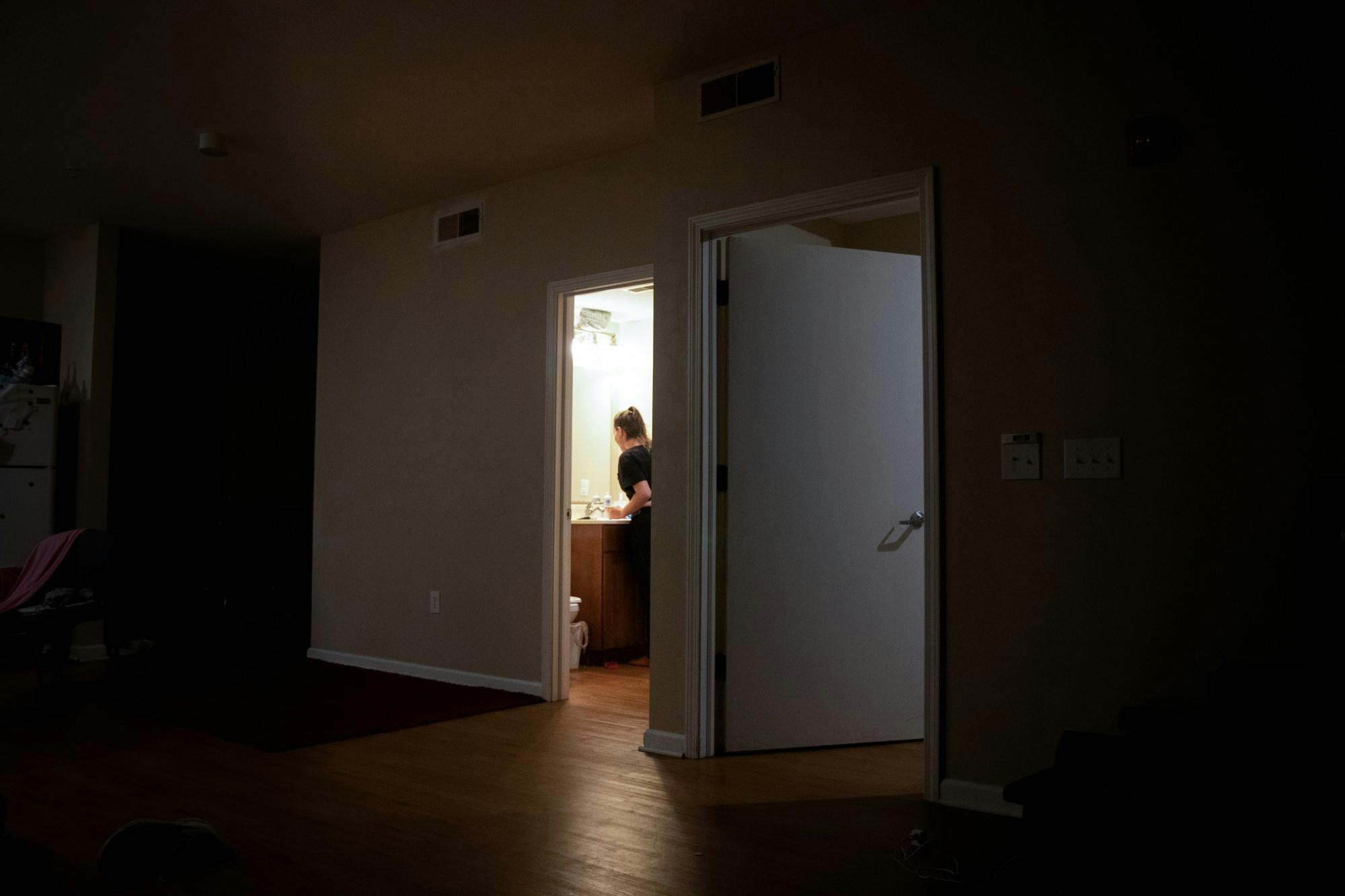
Growing up in Bedford, Jade said her family had a reputation. She said her parents were troublemakers. Much of her family struggled with substance use. She described five family members as addicts. Either way, Jade loved her family.
“I’m really really glad that I got to have the family that I do,” she said. “If I had any other one it’d probably be way boring.”
Drugs surrounded Jade as she grew up, and she said it felt like they became part of her. She called drugs one of her oldest relationships. Her drug use had gotten her in trouble — she was expelled as a freshman in high school because of it — but drugs had also given her interesting experiences and relationships with people she loved.
Her love of music and movies was tied up in drugs in a way that romanticized the simultaneously intense and care-free life of an addict. She loved Brittany Murphy’s badass, strung-out aesthetic in “Spun,” playing a meth addict named Nikki. She quoted Abbie Cornish in “Candy” pushing a line of heroin back to Heath Ledger and telling him, in a defiant Australian accent, “I want to try it your way this time.” She listened to the Grateful Dead and thought of driving to San Francisco to see where the band had lived.
“I just try to get things just right and make the moments like the movies that I saw,” she said. “I wanted to be a character that would be my favorite one.”
Twenty is an age when few people are able to see their futures clearly. Bloomington offered young people a college education as an accepted path to adulthood, but Jade was frozen. She had her GED, but her parents didn’t have the money for college, and even if she could get government assistance, she had a hard time envisioning a career worth going to college for.
Jade worried that whatever job she found would devour her life and make her miserable. She said she could be a hard worker but not if she didn’t see value in it. A mundane life wasn’t worth the time she had to be alive. But the adventurous life she had found was laced with danger. Jade had seen people slip away from reality in heroin’s grip. She said the drug hadn’t gotten her like that. She preferred meth, which didn’t come with the same urgency of finding another hit. Some days, Jade feared becoming a zombie. On others, she said she wanted to lose control.
Dr. Camila Arnaudo is an IU Health addiction psychiatrist who works with people seeking treatment for substance use disorders. Jade is not one of her patients, but Arnaudo often talks with young people like her.
But the people Arnaudo works with are seeking treatment. For most of her life, Jade viewed her relationship with drugs as mostly positive. She thought she was still young enough that she didn’t have to worry too much.
Arnaudo said she often sees denial in the people she treats. She said a man was in recently who didn’t believe the nurse practitioner when she told him the combination of drugs he was using was dangerous. He said he had been doing it for a while, and nothing bad had happened. Arnaudo tells patients she believes them, and their experience is valid, but that doesn’t mean something bad won’t happen in the future.
A few things tend to push people into treatment, Arnaudo said. Sometimes someone close to the person who needs help will bring them in, or the treatment center will hear from someone in the emergency room. Major medical consequences stemming from a substance use disorder can often send people into treatment.
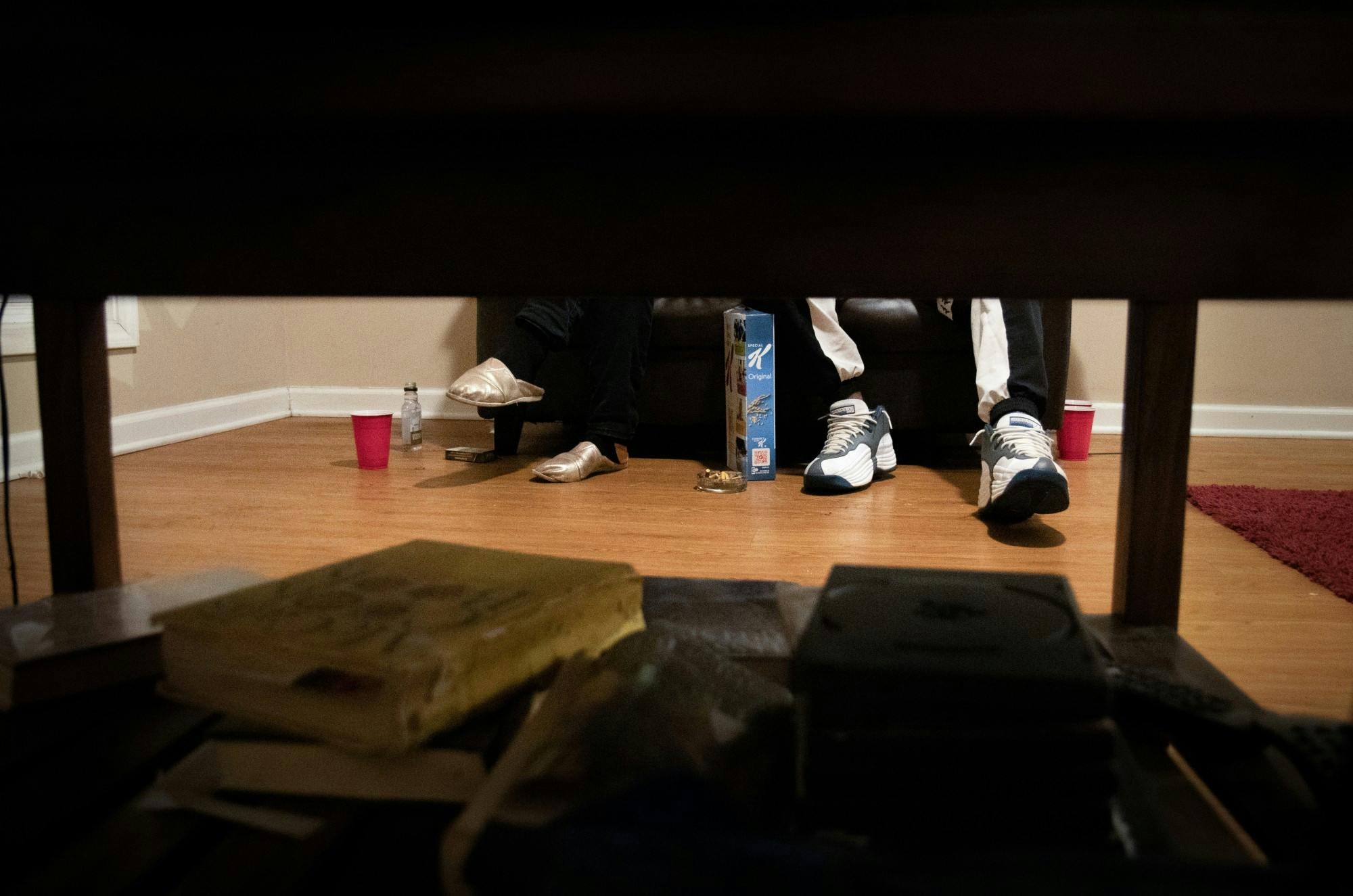
Arnaudo said a woman was recently in the hospital getting a heart valve replaced. She had endocarditis, a condition Arnaudo said was a somewhat common and extremely severe complication of drug use.
“You don't have to be a hardened drug user who has used for many years to get that,” she said. “It can be kind of sudden.”
What leads people into treatment, Arnaudo said, is when the balance in their mind is such that the benefits of stopping drug use outweigh the benefits of continuing. People need motivation to make a change in their behavior.
Jade had spent a few months in a residential treatment center when she was 15. She was sent there after being expelled from high school.
“It's very easy to fall into our old patterns because those are comfortable and our brain just knows those and just wants to do those,” Arnaudo said. “In order to do a pattern that's different, you need a lot of structure around it and you need to minimize the exposure to the things you naturally do.”
Alongside her addiction, Jade struggled with her mental health. There is a well-researched connection between substance use disorders and mental illness, particularly for women. Arnaudo has studied this connection and in 2017, she and two other researchers published a review article on the prevalence of mental illness overlapping with addiction.
Of people with substance use disorders, as high as 70% have another diagnosis such as depression, anxiety or PTSD, Arnaudo said.One reason people resume drug use is that addiction changes the part of people’s brains that helps them differentiate between positive and negative experiences through the release of certain chemicals, Arnaudo said. Drugs release huge amounts of those chemicals such as dopamine and serotonin. Things someone might typically enjoy like watching TV or spending time with family release a much smaller amount. An effect of addiction is that the brain cares less about those activities and craves a bigger bump of positive chemicals.
Another reason people go back to using drugs is that while they were staying sober, they didn’t build a life worth living, Arnaudo said. Some people white knuckle their way through treatment.
“The probation goes away, the baby is born, the thing that was keeping them immediately wanting to get clean goes away,” she said. “And then if you haven't helped them build other things that make their life meaningful, it's very very very difficult. And it's like a life and death kind of thing because often when they go back to using at that point, they will die.”
On a Saturday night in October, Jade’s aunt, Lisa Ricketts, had a few friends over at her apartment in South Bloomington. They were sitting together around a blank television set near the window.
The apartment was on the third floor of the Crawford. Lisa, 42, moved to Bloomington with her husband, Rhett, two and a half years ago because it had more resources for people experiencing homelessness than Bedford. They moved into the Crawford last year. Now Rhett was in jail, and Lisa was letting Jade keep some of her things on a patch of carpet next to the bathroom.
The Crawford is a program of Beacon, formerly Shalom Community Center, that offers permanent housing with supportive services for people who experience chronic homelessness due to disabilities, according to its website. Beacon’s services work to reduce hunger, poverty and homelessness in Bloomington. Beacon Director Rev. Forrest Gilmore said he knows the people the program helps out of homelessness face severe challenges including substance use disorders and that those problems don't go away when they get into housing.
"While the folks we work with absolutely have serious challenges, this is a harm reduction program whose purpose makes people's lives better," Gilmore said. "We don't claim that this suddenly totally turns a person's life around, but what we know is that it dramatically reduces harm and that over time it does lead to significant healing and improvement to people's lives."
Gilmore said new residents at the Crawford see about a 65% drop in emergency room use and about an 85% drop in incarceration rates.
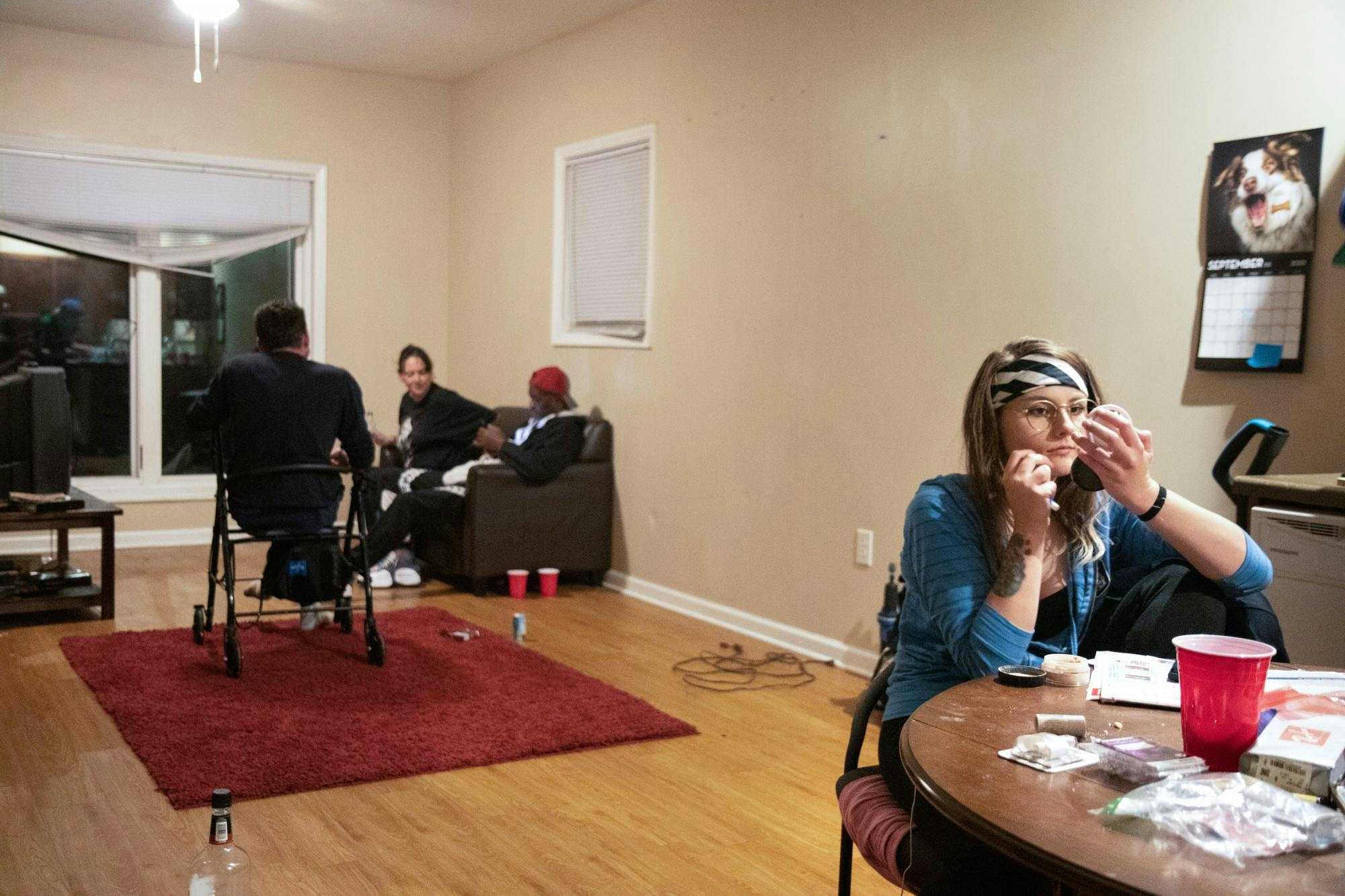
Lisa’s apartment was a sparse one bedroom, one bathroom with a nice view of the trees behind the building and the luxury of an ice machine in the freezer.
Earlier that night, Oct. 3, Lisa had an unusual encounter with a man who knocked on her door looking for drugs. He introduced himself by his first name, and Lisa let him in. He walked to her kitchen table and spread out packs of beef jerky. She retold the story to her neighbors from the couch hours later.
“Well he wants to know where the go is at,” Lisa said. “I don’t know if he thought we were going to trade him speed or give him cash — something for the beef jerky.”
“And he’s not on the wrong track,” Jade said from the kitchen. “Beef jerky’s fucking expensive.”
“It’s very true, very expensive,” Lisa said. “I mean it’s kind of weird you come up and it was a little . . .”
“Odd?” her neighbor said.
“It was odd, even for the Crawford,” Lisa said.
The man left, and then came back about half an hour later with a needle. He stood at the kitchen table and took off his loose-fitting yellow dress shirt.
“He proceeds to just jack it in,” Lisa said. She said she wasn’t sure what to do.
When Jade first moved to Bloomington, Lisa said she visited her and Rhett almost every day. Lisa looked after Jade like she was her daughter. Jade’s parents in Bedford checked on her, but when they didn't hear from her for a few days, they turned to Lisa.
But Lisa knew Jade wasn’t coming to the Crawford just to see her. She said Jade came to the Crawford to find drugs, and Lisa was a little concerned about her hanging around some of the apartments.
“I was not in this place at 20 years old,” Lisa said. “Was I addicted to drugs? Yeah. But I wasn't at the Crawford.”
Lisa said she liked having the apartment, but she also had issues with substance use, and she said it was too easy to buy or trade for drugs there. Lisa said some apartments were filled with people looking for drugs with nowhere to go.
Jade had visited Lisa a few times before moving to Bloomington. One thing that stuck with her were the people roaming the hallways knocking on doors and looking for someone to let them in. She called them zombies.

Jade recalled feeling stuck at the Crawford when she visited Lisa and hung out at apartments there in the spring. She said the place made her feel dissociated from the world around her. Normally Jade didn’t like to sit still, but she had the drugs she wanted at her disposal there, and she said she almost felt like she never had to leave.
“I realized I was going to become another zombie in the hallway,” Jade said.
Eventually, Jade started to spend more time outside away from the building. Aside from being at the mercy of the weather, Jade said she felt better when she was able to spend time outside in the summer months and sleep in Seminary Park.
Even then, Jade said she sometimes felt like her head got the best of her. She turned to Lisa for support. She said Lisa could remind her that she was pursuing her own genuine self, and that was okay.
“She makes me feel good about myself,” Jade said.
Later that month, Jade talked with Lisa about the idea of leaving Bloomington. If she could get a car, Jade said she could maybe move to Indianapolis. Jade said some of her problems were cleared up when she moved from Bedford. The same could be true for Bloomington.
Lisa told her the same problem would follow her everywhere.
“It’s in you,” she said.
Hunched over in a Starbucks dumpster Oct. 9 on South Walnut Street, Jade pulled apart trash bags and peered around with a flashlight. The dumpster smelled like a sugary latte with extra pumps of caramel. It was the best-smelling dumpster she would pick through that night, and she had just found what she was looking for.
Behind plastic wrappers and other trash, Jade pulled out a lemon loaf cake and showed it off.
Dumpster diving was partially something she just liked to do, but it was also a way to find clothes she could try to sell at Plato’s Closet or other things she could trade with people, such as headphones.
Jade continued to search, finding chocolate cake pops, bagels, Danishes, scones and breakfast sandwiches. There were a few coffee grounds on them, but they were mostly untouched. The Starbucks had closed a few hours ago, and crucially, Jade said the pastries hadn’t had enough time to absorb the flavor of the dumpster.
“It is no joke,” Jade said. “But I mean, that’s just the price you pay is accidentally tasting dumpster once in a while.”
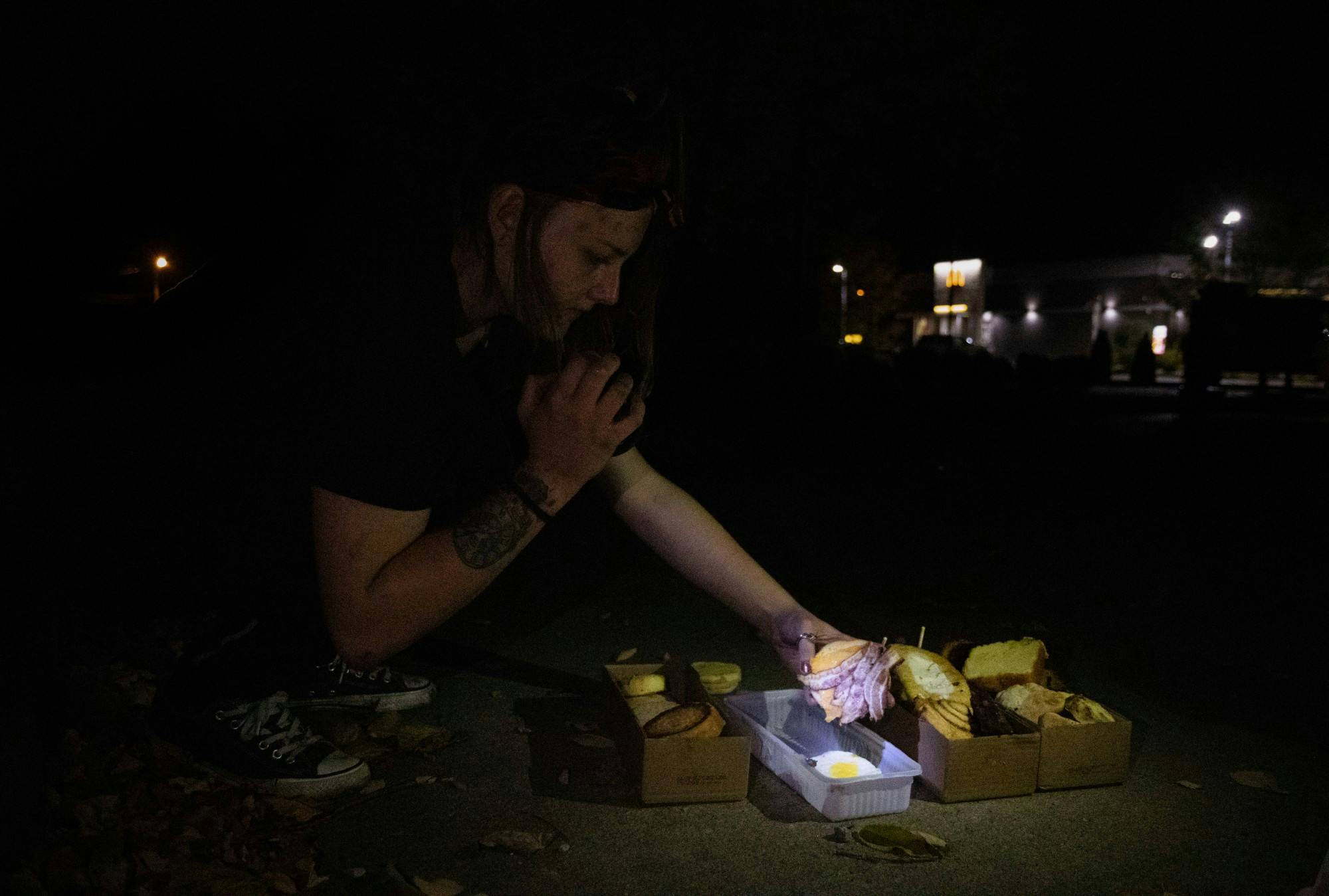
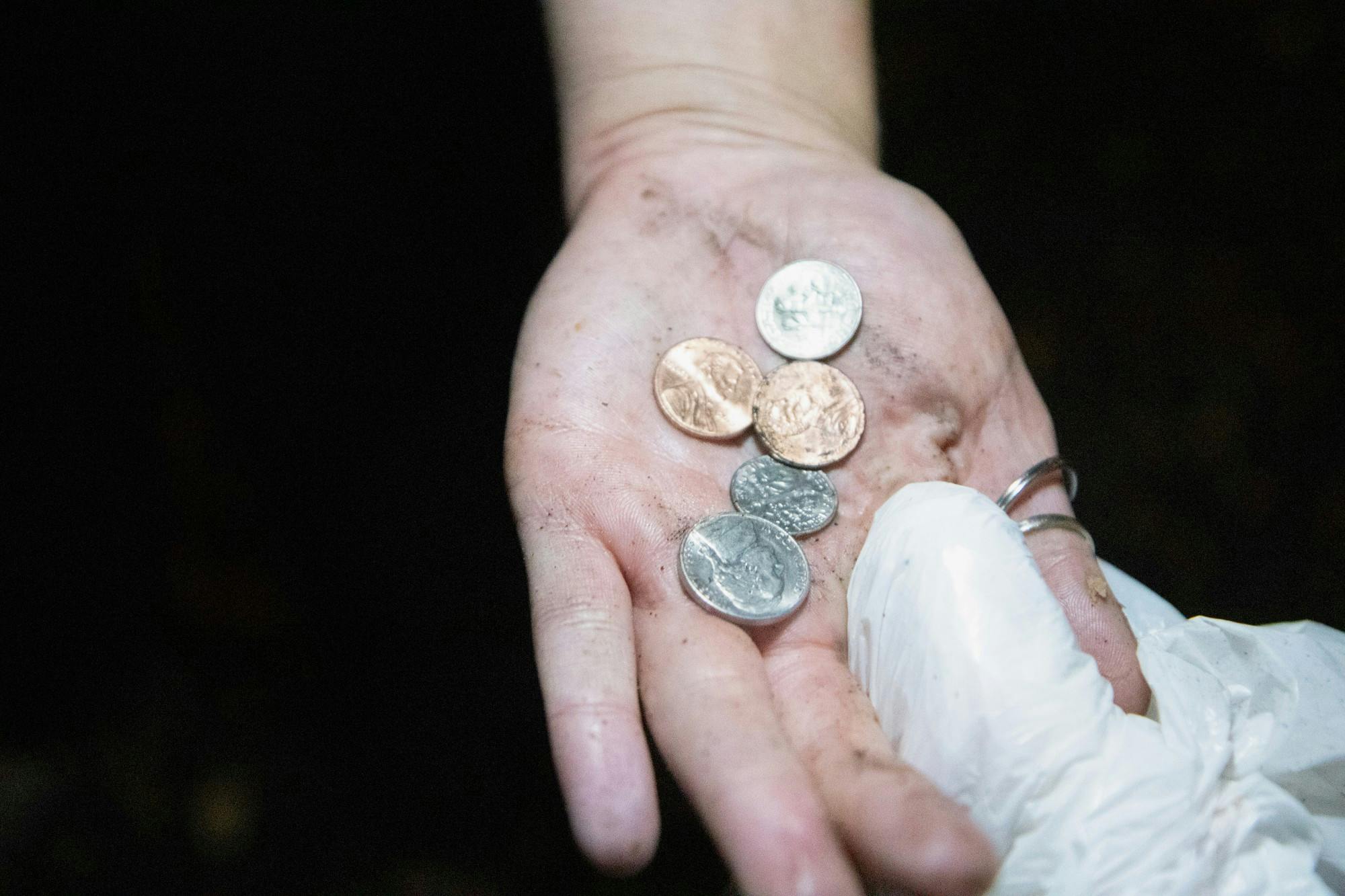
After going through the dumpster for half an hour, Jade walked around the drive-thru and shined her light on the ground. She was looking for change people might have dropped while paying for their orders. Once, she said she found a $10 bill. That night, she found 27 cents.
It was a Friday night, and a lot of people her age were searching for parties instead of change. On Grant Street in downtown Bloomington, college students were out on their lawns playing beer pong under strung up lights.
Jade said she preferred being homeless. The experience had taught her to let go of some of her anxieties, like talking to people she didn’t know very well. If she wanted to bum a cigarette, she had to learn to ask. Jade felt like she could coexist more naturally with other people than she could before she was homeless.
On the way to Starbucks earlier that night, Jade loosely quoted the agnostic 20th century philosopher Bertrand Russell: “The demand for certainty is one which is natural to man, but is nevertheless an intellectual vice.”
For some people, having certainty in life’s meaning is comforting, and Jade said she understood that. But for her, not ascribing meaning to the world set her free.
“I find the most fucking peace in oblivion,” Jade said.
Jade was enjoying the go-with-the-flow life she had found for herself in Bloomington. If her day took her to the East Side, she might spend a few days there. And why not? She was moving through the world with the firebrand conviction of her favorite movie characters and a dearth of responsibility. A bitter person might tell her to get over her frustrations with society’s constructs. That’s life. But Jade was young, and she acutely felt her own mortality. She didn’t want to waste her time.
But her lifestyle came with dangerous environments and occasionally unsavory characters. As temperatures fell and winter approached, tents popped up in Seminary Park where she had once cheerfully described her days in the sun. Jade liked the anonymity of living in a city, but she was missing a sense of community. She had the same criticism for the rest of the world.
“Everybody will steal you blind and not care,” Jade said.
One woman Jade befriended in Bloomington, Kim, said she had been homeless for seven years. Sitting with Jade in Switchyard Park in October, Kim said being homeless was the hardest thing she’d ever done. She was trying to get an apartment so she could spend time with her kids again. Jade's experience with homelessness hadn’t been as harsh. She never spent a night in a homeless shelter. If things got bad, she could fall back on family for at least a place to go.

Jade had some support systems, but drugs came with consequences, and she wasn’t unfamiliar with them. When Jade was sent to a residential treatment center in Indianapolis at 15 because of her drug use, she worked through the eight-month program quickly and was done in four or five months.
After treatment, Jade lived in a group home for a year until she moved back in with her grandmother at 17. Just before she turned 18, Jade moved out and started staying with friends in Bedford. She continued using drugs and spent a month in jail in 2019 for possession of meth.
Jade was 18 when she tried shooting up heroin for the first time. A guy she knew in Bedford drove her out to a bridge in the woods Sept. 18, 2018.
“It was beautiful out there,” Jade said. “And when he did it, he asked me how I felt, and all I said was Brittany Murphy.”
Jade talked a lot about trying to make her life a movie. If it was, the title card would now read “Hell.”
She was visiting Lisa with her boyfriend Oct. 21. Lisa was frustrated with the couple, and told them they needed to leave. Lisa had somewhere to be that night, and Jade had been complaining about feeling sick. Lisa thought she was just being whiney.
When Lisa got back to the apartment, she ran into a man in the hallway who told her Jade was downstairs, and she wasn’t doing well. She was lying on a mattress in the living room of someone’s apartment.
When Lisa went to check on her, Jade could hardly move or talk, and she had a fever. Lisa could feel her temperature from about 8 inches above her body. Lisa knew she hadn’t overdosed. If she had, the others in the apartment would have been hitting her with Narcan or throwing ice on her. Lisa didn’t know what was wrong.
Jade needed to get to a hospital. Lisa couldn’t call an ambulance from that apartment. She knew no one there would let her because cops would come too. She needed to get Jade to her third-floor apartment. Luckily, there was a wheelchair around, and the Crawford’s elevators were working.
Lisa called 911, and an ambulance came for Jade — along with the cops. Lisa told them she hadn’t overdosed, she was just really sick. The police asked for Jade’s name. Lisa started to give it to them, but stopped and told them she didn’t have to. She said it was a violation of medical privacy laws. The police didn’t push further.
Jade went to the IU Health Bloomington Hospital. Lisa called Jade’s mother and gave her the right phone numbers. Later, they found out Jade had a blood infection.
That night at the hospital, as Jade would later explain, she felt like she was in a dream state.
“I wasn't even real,” Jade said. “I barely remember anything out of it.”

After a few days, Jade was discharged from the hospital. She would have to get an infusion of antibiotics every day for two weeks. Jade was covered by her state health insurance. She asked the doctors what would happen if she missed an infusion. They told her to try not to miss one.
Her first infusion was Oct. 27, and Lisa went along. She said there was no one there as young as Jade.
Two days later at the Crawford, Lisa said she didn’t know how Jade was really feeling. Jade had told her she wasn’t shooting up anymore because she figured the blood infection came from a dirty needle. Lisa and Southside teased her that maybe the reason she got sick was she liked to eat pastries from dumpsters.
“I think she's having more fun than not, really,” Lisa said. “I don't think that she's really seeing the gravity of the situation.”
Lisa said she didn’t think anything bad enough had happened to Jade to make her want to stop using drugs.
Jade had to take the bus to the hospital each day for her infusions. On Sunday, the bus didn’t run, and Jade biked the two miles there on her own.
During her second week of treatment, Jade missed an infusion and started to feel sick again. She went to the emergency room Friday, Nov. 6, but they didn’t keep her overnight.
Later that weekend, she was admitted again. The blood infection had led to a mass of bacteria forming on one of her heart valves causing inflammation. Jade had endocarditis, the condition Dr. Arnaudo said was a somewhat common and extremely severe complication of drug use. To treat it, Jade needed six weeks of daily IV antibiotics. If for some reason they didn’t work, she might need open heart surgery.
Calling from the hospital Nov. 9, Jade said what had been on her mind.
“Just kinda hoping I don’t die,” she said.
Jade said she thought she was feeling OK, but she was scared. It wasn’t just the blood infection. She feared her mental health was getting worse.
Jade loved watching horror movies with her mom as a child. But now she couldn’t even watch a preview of a horror film without it messing with her for days or weeks. She said she would close her eyes and see the images over and over. She couldn’t stop it.
Jade knew she needed to quit drugs. She felt like giving them up meant losing part of her identity. Jade compared it to someone growing up loving reading and writing while being surrounded by writers in their family. And then one day writing started killing them.
“I'm terrified,” she said. “I have to stop or it will kill me. And I don't know if I can, but I have to try.”
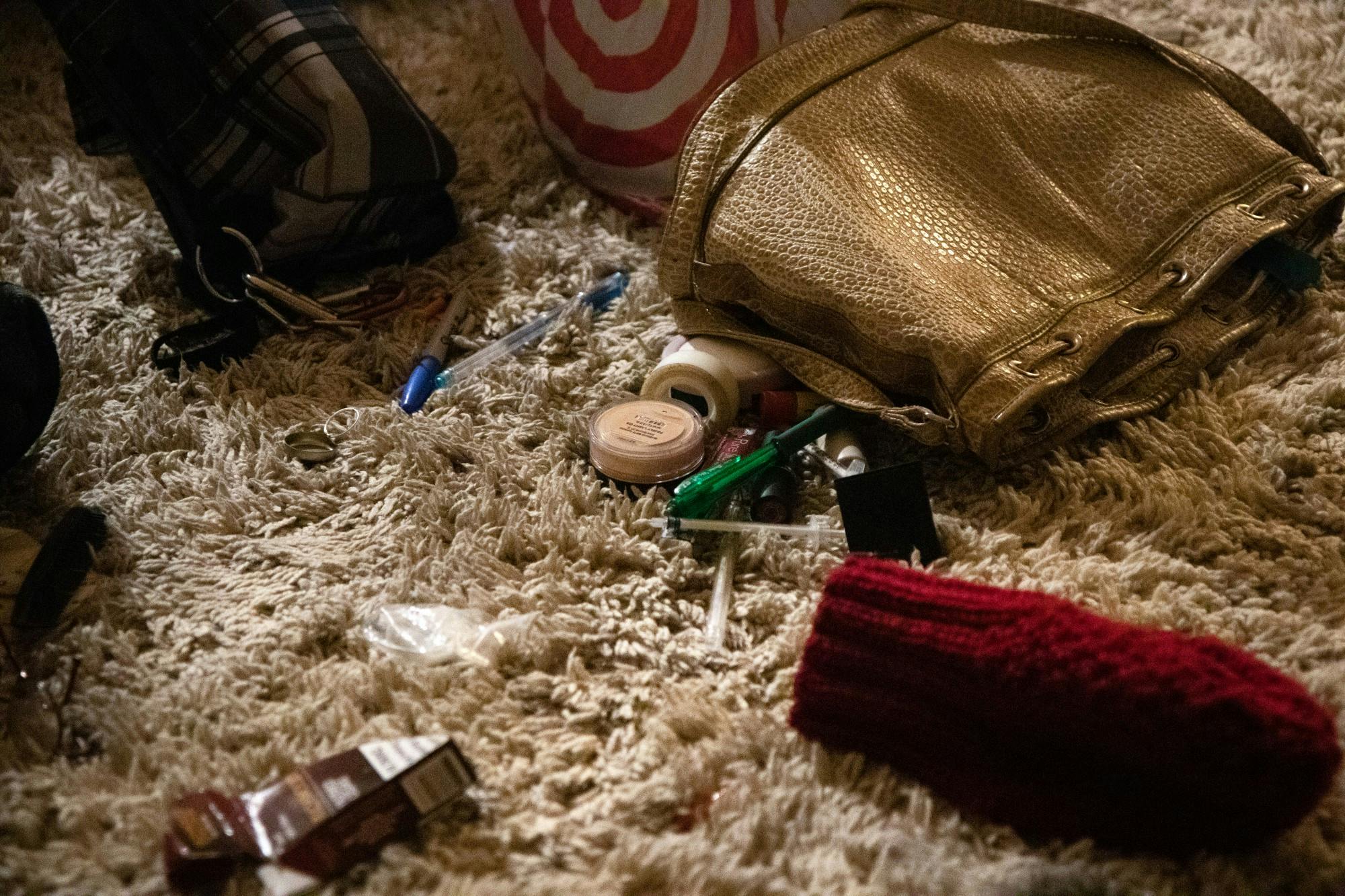
Jade was moving back in with her grandparents in Bedford so she could make it to all of her treatments. They were planning to drive up to Bloomington to bring her back Nov. 16, and the day before, she was feeling nervous about the weeks ahead.
She liked her grandparents, but she didn’t have much in common with them, and was dreading moving in. She wasn’t sure how she would occupy her time. She planned on applying to temporary jobs so she could save money for a car.
On the car ride to Bedford, Jade cried. She said she thought about ignoring the infusions and just dying. But once she got settled, Jade said she was feeling better than she anticipated. She didn’t like Bedford, but she appreciated its familiarity.
In a phone interview Dec. 12, Jade said trying to cut out drugs had been difficult. She said she messed up a few times. She also missed one of her infusions, but she said she didn’t get sick as a result. Jade had intended to stay at her grandparents house, but she didn’t actually spend much time there. Now, she spends most of her time at a place in Bedford she called a “historically landmarked tweaker pad.”
Jade is 21 now. She still has a few weeks of treatment to go. Once she’s finished, she plans on trying to get a car to go back to Bloomington. She doesn’t plan to stop using drugs.
"I'm probably never going to be a totally sober person,” Jade said. “And I mean yes, I will always proceed with caution. And I even did before. That's the fucked up thing of me of all people getting this. I'm cautious. I'm very cautious.”
Despite her continued substance use, Jade’s mental health is improving. She’s listening to music and watching movies that she hadn’t in a long time. She could handle horror movies better than she did in Bloomington. When she first got to Bedford, she watched the 2013 remake of “Evil Dead.”
Jade has also gotten back into writing again. She writes down things she notices, appreciates or doesn’t want to forget in a sparkly blue notebook.
“Selfish, fucked up brats you spawned to replace yourself. Choose your future,” she wrote in it, quoting “Trainspotting.” “Choose life . . . But why would I want to do a thing like that? I choose not to choose life. I choose somethin’ else. And the reasons? There are no reasons. Who needs reasons when you’ve got heroin?”
This story is based on three months of reporting. Peter Talbot and Elle Kreamer followed Jade Wessel’s life from September to December by spending hours with her in-person while wearing masks in Seminary Park, her aunt’s apartment and around Bloomington. They never witnessed Jade use drugs and did not know about her substance use until she went to the hospital months after the reporting process began. The reporters witnessed many of the scenes in the story and based the rest on interviews with Jade and Lisa.

